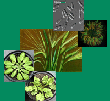| Roth, U; von Roepenack-Lahaye, E; Clemens, S: Proteome changes in Arabidopsis thaliana roots upon exposure to Cd2+, J. Experimental Botany, Vol. 57(No. 15), 4003-4013 (2006), doi:10.1093/jxb/erl170 | |
| Abstract: Cadmium is a major environmental pollutant that enters human food via accumulation in crop plants. Responses of plants to cadmium exposure—which directly influence accumulation rates—are not well understood. In general, little is known about stress-elicited changes in plants at the proteome level. Alterations in the root proteome of hydroponically grown Arabidopsis thaliana plants treated with 10 μM Cd2+ for 24 h are reported here. These conditions trigger the synthesis of phytochelatins (PCs), glutathione-derived metal-binding peptides, shown here as PC2 accumulation. Two-dimensional gel electrophoresis using different pH gradients in the first dimension detected on average ∼1100 spots per gel type. Forty-one spots indicated significant changes in protein abundance upon Cd2+ treatment. Seventeen proteins found in 25 spots were identified by matrix-assisted laser desorption/ionization time-of-flight mass spectrometry. Selected results were independently confirmed by western analysis and selective enrichment of a protein family (glutathione S-transferases) through affinity chromatography. Most of the identified proteins belong to four different classes: metabolic enzymes such as ATP sulphurylase, glycine hydroxymethyltransferase, and trehalose-6-phosphate phosphatase; glutathione S-transferases; latex allergen-like proteins; and unknown proteins. These results represent a basis for reverse genetics studies to better understand plant responses to toxic metal exposure and to the generation of internal sinks for reduced sulphur. |

